How to Organize Your Kitchen the Minimalist Way
Category: Lifestyle
Embrace a Clutter-Free Kitchen: Minimalist Organization Made Simple
If you've found yourself overwhelmed by kitchen clutter, constantly searching for a lost utensil or juggling too many gadgets, you're not alone. Many who gravitate towards minimalism aim for a kitchen space that sparks joy yet functions efficiently without excess. Whether you're a minimalist novice or someone eager to transform your cooking space into a sanctuary of simplicity, this post is tailored for you. You'll discover actionable steps to declutter, organize, and maintain your kitchen with intentionality and calm. This guide goes beyond surface-level tidying, focusing on mindful doing so you can savor clarity, ease, and fulfillment in daily kitchen moments. By the end, you'll be equipped with practical tools and fresh inspiration to create a kitchen that serves you well — freeing your mind and elevating your lifestyle. Keep reading to start your minimalist kitchen journey with insights trusted by simplicity enthusiasts.
- Embrace a Clutter-Free Kitchen: Minimalist Organization Made Simple
- Evaluate Your Kitchen Essentials: Prioritize Quality and Multifunctionality
- Decluttering Strategies for Minimalist Kitchens: Purge Excess Without Guilt
- Smart Storage Solutions: Maximize Space with Minimalist Efficiency
- Zone Your Kitchen for Efficiency: How to Arrange Your Kitchen into Functional Zones
- Choosing Minimalist Kitchen Tools and Appliances: Select Versatile, Efficient, and Simple Essentials
- Minimalist Pantry Organization: Techniques for Transparent Storage, Labeling, and Keeping a Limited but Wholesome Range of Food Staples
- Maintain Minimalism with Daily Habits: Building Routines to Sustain a Tidy, Minimalist Kitchen Long-Term
- Incorporating Mindful Practices in Kitchen Use: Enhance Minimalism and Well-Being Through Intentionality
- Styling a Minimalist Kitchen Space: Ideas for Simple Decor, Neutral Palettes, and Natural Materials
- Sustainable Minimalism in the Kitchen: Eco-Friendly Choices to Reduce Waste and Simplify Your Kitchen Footprint
Evaluate Your Kitchen Essentials: Prioritize Quality and Multifunctionality
The cornerstone of a truly minimalist kitchen lies in carefully evaluating your kitchen essentials. This means taking a close, honest inventory of what you genuinely use versus what simply sits unused or duplicates other tools. Begin by pulling out all your utensils, cookware, and gadgets, then ask yourself:
- Have I used this in the past 3–6 months? If not, it’s a strong candidate for removal.
- Does this item serve multiple purposes? Favor tools that streamline tasks instead of single-use gadgets.
- Is this item durable and high-quality? Investing in fewer, better pieces ensures longevity and cuts down on clutter over time.
By focusing on quality over quantity, you create not just physical space but mental clarity when cooking or cleaning. For example, choose a sharp chef’s knife that can handle chopping, slicing, and dicing rather than multiple specialty knives. Opt for versatile cookware like a cast-iron skillet that works on stovetop and oven, replacing several pans.
This conscious curation transforms your kitchen into an efficient and calming environment — built from items that you truly need, love, and use regularly. Especially for minimalists, this step sets the foundation for effortless organization that is sustainable and satisfying.

Image courtesy of Rachel Claire
Decluttering Strategies for Minimalist Kitchens: Purge Excess Without Guilt
Decluttering your kitchen is a pivotal step toward embracing minimalism, yet it can often feel overwhelming or evoke unnecessary guilt about letting go. To minimize stress and maximize success, approach the process with clear, step-by-step strategies that help you part with excess cookware, utensils, appliances, and pantry items mindfully and confidently.
Step 1: Categorize and Assess Items
Begin by dividing your kitchen contents into clear categories: - Cookware (pots, pans, bakeware) - Utensils and gadgets - Small appliances - Pantry goods and spices
Within each category, apply these guiding questions: 1. Have I used this recently, within 3 to 6 months? Items unused during this period are prime candidates for donation or recycling. 2. Does this item duplicate the function of another tool I own? Keep the best quality or most multifunctional piece. 3. Is this appliance or gadget adding value to my routine, or does it just create clutter?
Step 2: Use the "Three-Box Method"
Prepare three boxes labeled Keep, Donate/Sell, and Discard. As you handle each item, place it immediately into one of these boxes based on your assessment. This physical separation speeds up decision-making and creates a tangible sense of progress.
Step 3: Set Emotional Boundaries
Minimalism honors intentional choices, not deprivation. If sentimental attachment causes hesitation, ask yourself: - Does keeping this item truly serve my present life and kitchen efficiency? - Could photographing it provide the memory without the physical space?
Release guilt by remembering that decluttering is about making room for what matters most—not about perfection or waste.
Step 4: Streamline the Pantry
For pantry items, focus on: - Checking expiration dates and tossing expired goods. - Consolidating duplicates (e.g., combine partially used bags of flour). - Keeping only staples and ingredients you use regularly.
By methodically purging excess, your minimalist kitchen will feel lighter, cleaner, and more inviting. These decluttering strategies empower you to maintain clarity and functionality while cultivating a kitchen that reflects mindful simplicity — essential for fostering calm, joy, and ultimate ease in your cooking space.
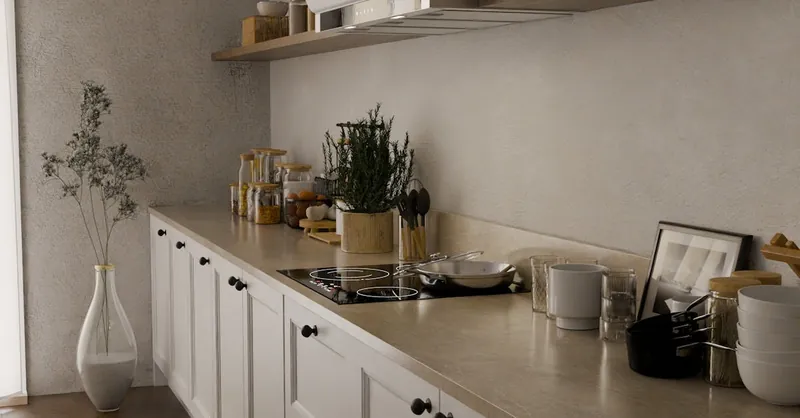
Image courtesy of Jivitharsan Suresh
Smart Storage Solutions: Maximize Space with Minimalist Efficiency
Once you’ve decluttered and curated your kitchen essentials, the next vital step is to implement smart storage solutions that maintain a clean, open, and inviting kitchen environment. Effective storage transforms your minimalist kitchen from simply neat to a thoughtfully designed oasis, where every item has its place and accessibility is effortless.
Utilize Drawer Organizers for Streamlined Accessibility
One of the simplest yet most impactful ways to keep your kitchen tidy is by using drawer organizers. These customizable dividers help compartmentalize utensils, knives, and small gadgets, preventing items from scattering and creating visual chaos. Consider:
- Adjustable or modular drawer inserts to accommodate different utensil sizes.
- Dedicated sections for frequently used tools to speed up meal prep.
- Minimalist designs—clear acrylic or bamboo—to blend seamlessly with your kitchen aesthetic.
Drawer organizers not only enhance efficiency but also encourage consistent tidiness by guiding where items belong, making it easier to maintain daily.
Embrace Minimalist Shelving: Open, Floating, and Multi-Functional
Minimalist shelving is a powerful way to keep essentials within reach without overcrowding surfaces or cabinets. Opt for open or floating shelves that showcase only carefully chosen items like your best cookware, glassware, or simple decor to maintain a sense of openness. Benefits include:
- Visual lightness that prevents your kitchen from feeling boxed in.
- Easy access to frequently used items, reducing the need to open multiple cabinets.
- Encouragement to keep only what you truly need visible, discouraging clutter buildup.
For a cohesive look, select shelves in natural wood, black metal, or neutral tones that complement your kitchen’s color scheme.
Maximize Vertical Space: Think Beyond Countertops and Cabinets
Minimalism thrives on making use of every inch of available space—especially vertical areas that are often overlooked. Effective vertical storage techniques include:
- Installing wall-mounted racks or pegboards for hanging pots, pans, and utensils. This frees up cabinet space and adds a functional design element.
- Utilizing magnetic strips for storing knives or metal tools safely and visibly.
- Adding tall, slim shelving units or pantry organizers that fit narrow spaces, capitalizing on height rather than width.
By embracing vertical storage, you reduce countertop clutter and maintain a clean, open feel throughout your kitchen. This also promotes ease of movement and a stress-free cooking experience.
Implementing drawer organizers, minimalist shelving, and vertical storage solutions are key strategies to maintaining a minimalist kitchen that feels spacious, organized, and highly functional. These approaches support your commitment to simplicity by maximizing space without excess, creating a kitchen environment that truly nurtures calm and clarity.
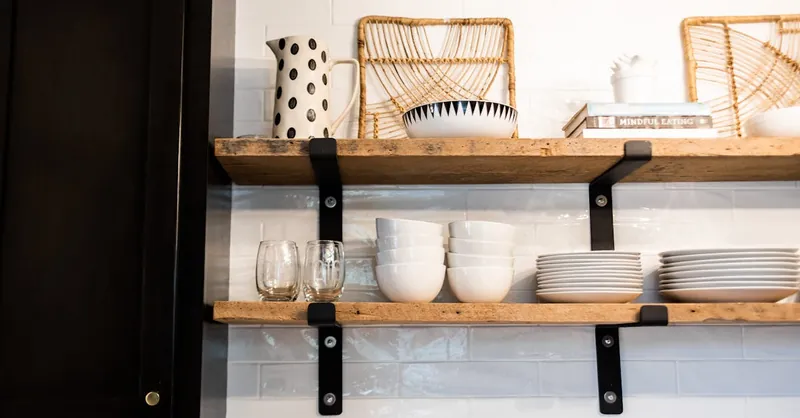
Image courtesy of Caleb Oquendo
Zone Your Kitchen for Efficiency: How to Arrange Your Kitchen into Functional Zones
Creating a minimalist kitchen goes beyond decluttering and smart storage—it requires intentional zoning that aligns with how you cook, prep, and clean. By dividing your kitchen into clearly defined functional zones such as prep, cooking, and cleaning areas, you can streamline your workflow, reduce unnecessary movement, and keep clutter to a minimum. This approach maximizes efficiency and helps maintain a calm, orderly space that effortlessly supports your daily routines.
Establish Key Kitchen Zones
-
Prep Zone
Position your cutting boards, knives, mixing bowls, measuring cups, and frequently used ingredients close together. This zone should ideally be near both your fridge and the sink for easy access to fresh items and water. Keeping all prep tools in one spot not only reduces clutter but also accelerates meal preparation. -
Cooking Zone
Include your stove, oven, pots, pans, spatulas, and cooking oils here. Arrange cookware and utensils so they’re within arm’s reach of your heat source. For a minimalist kitchen, prioritize keeping only what you need daily, storing extras neatly elsewhere to maintain a clean counter workspace. -
Cleaning Zone
Designate the area around your sink and dishwasher (if you have one) as your cleaning station. Store dish soaps, scrubbers, towels, and trash bins here. This separation prevents cleaning supplies from invading other zones and keeps things tidy, making post-meal cleanup smooth and intuitive.
Tips to Optimize Zone Workflow
- Keep Traffic Flow in Mind: Zones should be arranged to support a natural cooking cycle—from retrieving ingredients, prepping, cooking, to cleaning up—with minimal backtracking.
- Limit Overlapping Items: Avoid scattering tools across multiple zones; assign specific homes for each item to reduce decision fatigue and improve organization.
- Use Clear Containers and Labels: Especially in the prep and pantry areas, this promotes quick identification and reinforces the minimalist ethos of simplicity.
By zoning your kitchen thoughtfully, you create a functional, clutter-free environment that enhances your cooking experience and upholds minimalist principles. This kitchen layout not only fosters efficiency but also supports a peaceful, enjoyable space where every item has a clear purpose and place.
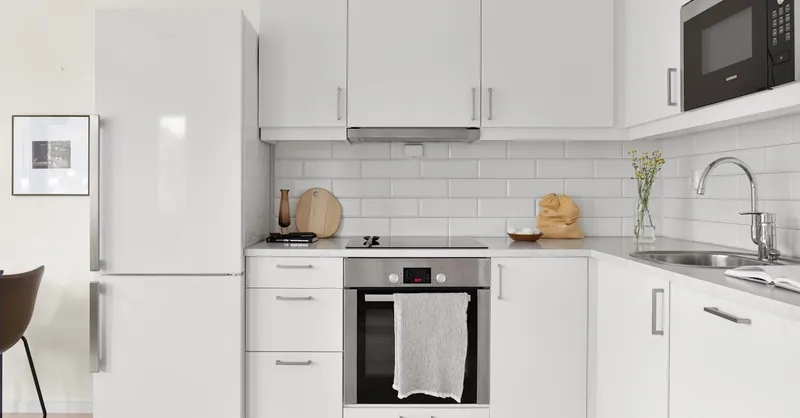
Image courtesy of Alex Tyson
Choosing Minimalist Kitchen Tools and Appliances: Select Versatile, Efficient, and Simple Essentials
When curating a minimalist kitchen, the selection of tools and appliances is as important as decluttering and organizing. Choosing kitchen tools that are versatile, efficient, and visually simple helps maintain a clean, streamlined space that embodies minimalist principles while supporting functionality. Instead of accumulating numerous single-purpose gadgets, focus on multi-functional, compact tools that reduce clutter and maximize usability.
Key Tips for Selecting Minimalist Kitchen Tools and Appliances
-
Prioritize Multipurpose Items
Select tools and appliances that perform a range of tasks. For example, a high-quality blender that can puree, chop, and even blend dough replaces several single-use devices. Similarly, opt for a food processor with multiple attachments instead of buying separate gadgets for slicing, grating, and kneading. -
Choose Compact and Lightweight Designs
Minimalist kitchens benefit from items that don’t overwhelm your storage space or countertop. Look for compact appliances that tuck away easily and tools with slim profiles to keep your kitchen visually open and uncluttered. -
Favor Simple, Timeless Aesthetics
Streamlined designs in neutral colors like black, white, stainless steel, or natural wood tones complement minimalist decor. Avoid overly ornate or bulky designs that draw unnecessary attention and disrupt visual harmony. -
Invest in Quality Over Quantity
Durable, well-made tools last longer and perform better, reducing the need for replacements and thus supporting sustainable minimalism. For example, a sturdy stainless steel chef’s knife or a cast iron skillet will endure years of use and serve multiple cooking needs brilliantly. -
Evaluate Appliance Necessity
Before purchasing, assess how regularly you’ll use the appliance. Avoid impulse buys of trendy gadgets that add clutter but rarely get used. Stick with essentials like a good coffee maker, toaster oven, or induction cooktop if these truly fit your cooking habits.
Implementing these tips when selecting your kitchen tools and appliances aligns your cooking space with minimalist values—ensuring simplicity, efficiency, and beauty coexist. This thoughtful approach not only maintains order but also enhances your cooking experience by surrounding you with only what you need and love.
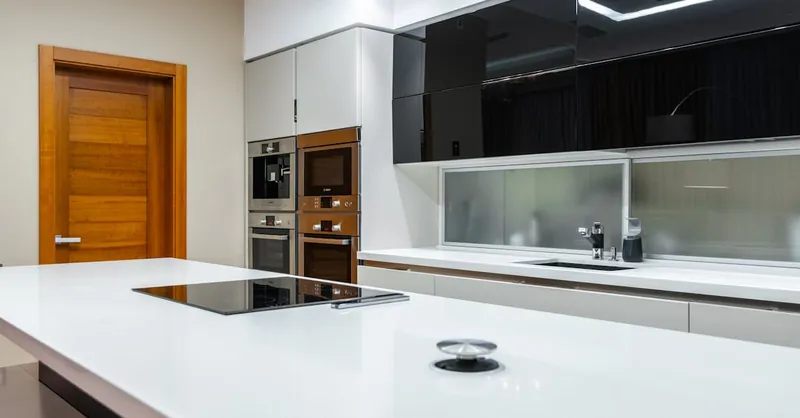
Image courtesy of Max Vakhtbovycn
Minimalist Pantry Organization: Techniques for Transparent Storage, Labeling, and Keeping a Limited but Wholesome Range of Food Staples
A well-organized minimalist pantry is essential for maintaining clarity and simplicity in your kitchen. The key lies in transparent storage, clear labeling, and carefully selecting a limited yet wholesome range of food staples that support healthy, varied meals without excess clutter. By embracing these techniques, you can transform your pantry into a visually appealing, functional space that encourages mindful cooking and effortless maintenance.
Transparent Storage for Visual Clarity and Freshness
Using clear, airtight containers made of glass or BPA-free plastic allows you to see exactly what you have at a glance—eliminating mystery and minimizing duplicate purchases. Transparent storage also keeps food fresher for longer while maintaining a streamlined look. Prioritize containers with uniform shapes and stackability to maximize space efficiency and create a clean, cohesive aesthetic.
Systematic Labeling to Simplify Navigation
Labeling pantry containers and shelves is vital for quick identification and maintaining order. Use simple, legible labels to denote contents and expiration dates, either with a label maker or elegantly hand-written tags. Consistent labeling helps everyone in the household find ingredients easily and encourages returning items to their designated spots, preserving your minimalist pantry’s neatness over time.
Curate a Limited but Nutritious Food Selection
Minimalism in the pantry means focusing on quality and variety within a smaller range of staples, rather than hoarding bulk items that may go unused. Build your pantry around versatile, wholesome ingredients such as:
- Whole grains (brown rice, quinoa, oats)
- Legumes (lentils, chickpeas, beans)
- Healthy oils (extra virgin olive oil, coconut oil)
- Basic dried herbs and spices
- Minimal processed goods, focusing on whole foods
By regularly reviewing and replenishing only what you consume, you prevent food waste and keep your pantry lean yet nutritionally rich. This mindful approach supports both simplicity and well-being, hallmarks of a truly minimalist kitchen.
Together, these strategies for transparent storage, clear labeling, and thoughtful selection of pantry staples create a calming, efficient food storage system. Your minimalist pantry will not only enhance your kitchen’s visual harmony but also nurture a balanced, intentional approach to cooking and eating.
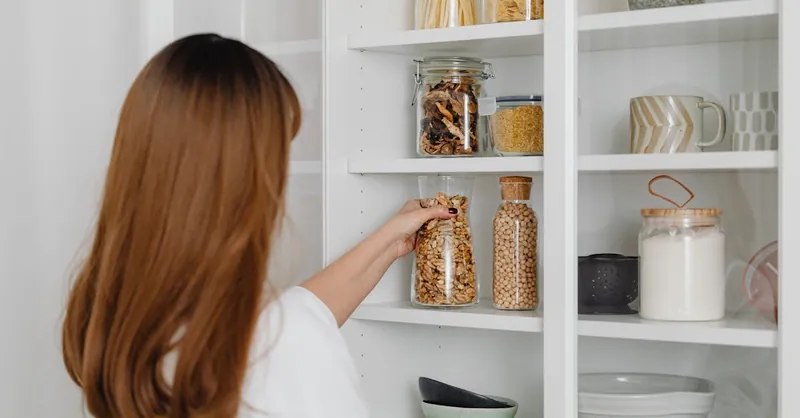
Image courtesy of Photo By: Kaboompics.com
Maintain Minimalism with Daily Habits: Building Routines to Sustain a Tidy, Minimalist Kitchen Long-Term
Creating a beautifully organized minimalist kitchen is only the beginning—sustaining that calm, clutter-free space requires intentional daily habits that prevent re-cluttering and promote ongoing simplicity. By integrating a few mindful routines into your everyday kitchen use, you ensure that your minimalist kitchen remains efficient, inviting, and stress-free for the long haul.
Key Daily Habits to Preserve Your Minimalist Kitchen
-
Practice the “Clean as You Go” Method
Washing dishes, wiping counters, and putting away utensils immediately after use prevents build-up of clutter and mess. This habit keeps surfaces clear and reduces the need for overwhelming deep cleans, sustaining a fresh, minimalist environment daily. -
Return Items to Their Designated Zones
Making a conscious effort to always return tools, cookware, and ingredients to their assigned zones or storage places reinforces order and makes finding items effortless. This habit eliminates stray items lingering on countertops or migrating from one area to another, which is a major cause of kitchen clutter. -
Conduct a Quick Evening Tidy-Up
Spend 5–10 minutes each evening to put away leftovers, wipe down surfaces, and arrange pantry items. Setting this small but consistent routine builds momentum and helps prevent clutter accumulation overnight, so you start each day with a clean, organized kitchen. -
Regularly Reassess and Edit Your Essentials
Schedule a monthly or quarterly review of your kitchen tools and pantry staples, removing rarely used items and expired foods. This ongoing evaluation supports minimalist ideals by preventing the slow creep of unnecessary possessions, ensuring your kitchen evolves with your needs without becoming overcrowded.
By embedding these simple daily practices into your lifestyle, you create a sustainable rhythm that keeps your minimalist kitchen pristine and functional. These habits not only save time and reduce stress but also deepen your connection to intentional living—where every object has its place, and every kitchen moment is savored with clarity and ease.
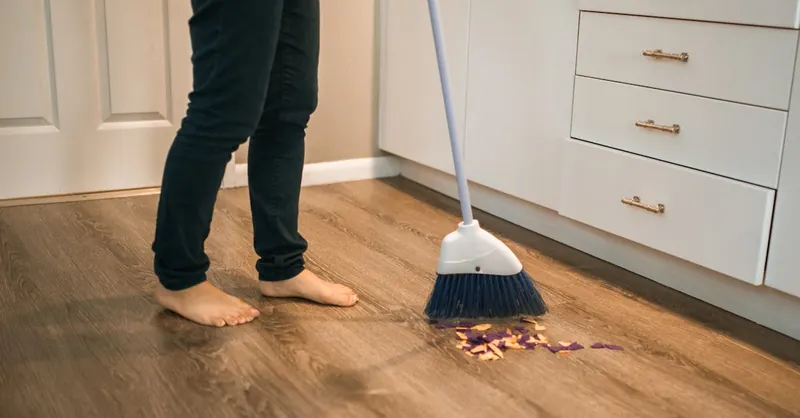
Image courtesy of RDNE Stock project
Incorporating Mindful Practices in Kitchen Use: Enhance Minimalism and Well-Being Through Intentionality
Beyond decluttering and organizing, embracing mindful practices in your kitchen activities deepens the connection between minimalism and overall well-being. Being intentional and fully present while cooking, cleaning, and using your kitchen transforms everyday tasks from rushed chores into moments of calm and fulfillment. This mindful engagement not only supports a clutter-free environment but also fosters mental clarity and reduces stress.
How Mindfulness Elevates Your Minimalist Kitchen Experience
-
Slow Down and Savor Each Step
Instead of multitasking or rushing, practice focusing on one task at a time—whether chopping vegetables, washing dishes, or arranging your pantry items. This slows your pace, reduces errors, and allows you to appreciate the sensory experience of cooking, fostering gratitude and joy. -
Engage All Your Senses
Pay close attention to the colors, textures, smells, and sounds involved in your kitchen routines. This sensory awareness encourages you to value the quality and simplicity of your environment, reinforcing minimalist values of clarity and purpose. -
Practice Intentional Use and Maintenance
Treat each kitchen item with care, recognizing the thought behind its place in your home. Being mindful about how and when you use tools or appliances discourages wasteful habits and supports sustainable minimalism by prolonging their lifespan. -
Reflect on Your Needs and Habits Regularly
Mindfulness invites periodic reflection on whether your kitchen practices and possessions still serve your lifestyle and values. This ongoing awareness helps avoid accumulating unnecessary items or inefficient routines, keeping your kitchen aligned with simplicity and well-being.
By weaving mindful presence and intention into your kitchen usage, you cultivate a space where minimalism flourishes naturally. This approach transforms your kitchen from a static space into a sanctuary of purposeful action and peaceful living, enhancing not just the look of your kitchen, but also the quality of your daily life.

Image courtesy of Thượng Hy
Styling a Minimalist Kitchen Space: Ideas for Simple Decor, Neutral Palettes, and Natural Materials
Creating a minimalist kitchen isn’t just about decluttering and organizing; style plays a crucial role in fostering an atmosphere of calmness and timelessness that enhances your everyday experience. A minimalist kitchen design hinges on simplicity, subtle elegance, and natural elements that together promote tranquility and visual coherence. To style your kitchen with minimalist flair, focus on these core principles:
Embrace Neutral Color Palettes
Neutral tones like soft whites, gentle beiges, warm greys, and muted earth shades provide a serene backdrop that visually expands your kitchen space and allows essential elements to shine without distraction. These colors evoke calmness and make the kitchen feel clean and inviting. Consider:
- Painting walls and cabinets in matte or satin finishes of neutral hues to reduce glare and maintain softness.
- Using subtle contrasts—such as a charcoal countertop paired with off-white cabinets—to add depth without cluttering the palette.
- Incorporating natural wood tones to warm up the space while keeping it understated.
Opt for Natural, High-Quality Materials
Materials like wood, stone, ceramic, and linen anchor your minimalist kitchen in authenticity and timelessness. They add visual texture and warmth without overwhelming the senses. Key materials to incorporate:
- Wood: Choose sustainably sourced wooden cutting boards, open shelving, or utensil handles for organic appeal.
- Stone or Quartz: Use durable stone countertops or backsplash tiles in natural shades that age gracefully.
- Ceramic: Select simple, handcrafted ceramic dishware in matte or neutral finishes to add artisanal charm.
- Textiles: Employ linen or cotton towels and placemats in soft, muted colors for understated elegance.
Keep Decor Purposeful and Minimal
To sustain minimalism, decorative items should be functional or hold intentional aesthetic value. Avoid overcrowding surfaces with knick-knacks, instead showcasing a few carefully curated pieces such as:
- A single vase with freshly cut greenery or dried botanicals.
- Minimalist salt and pepper mills or olive oil dispensers with clean designs.
- Simple, elegant pendant lighting or sconces that complement the color scheme and materials.
Harness Light and Space for an Airy Feel
Maximize natural light with unobstructed windows and sheer window coverings to create an open, bright environment. Reflective surfaces like glass, stainless steel, or light-toned cabinetry enhance luminosity without compromising warmth. Additionally, leaving ample empty space on countertops and shelves is essential—it allows your kitchen to breathe and prevents visual clutter, reinforcing minimalist ideals.
By integrating these styling strategies—neutral palettes, natural materials, purposeful decor, and thoughtful use of light and space—your minimalist kitchen becomes a sanctuary where simplicity meets timeless beauty. This environment not only supports mental calm but also elevates your cooking and dining experiences with effortless elegance.
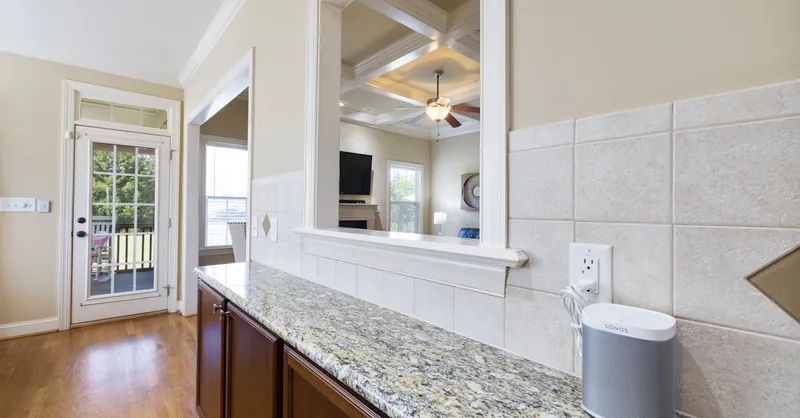
Image courtesy of Curtis Adams
Sustainable Minimalism in the Kitchen: Eco-Friendly Choices to Reduce Waste and Simplify Your Kitchen Footprint
Embracing sustainable minimalism in the kitchen means intentionally choosing eco-friendly practices that reduce waste, conserve resources, and simplify your kitchen's environmental footprint—all while maintaining a minimalist aesthetic. This approach aligns with the core minimalist value of thoughtful consumption by prioritizing durability, reusability, and waste reduction over convenience or excess.
Key Strategies for Sustainable Minimalist Kitchens
-
Invest in Reusable and Durable Kitchenware
Opt for kitchen tools, containers, and dishware made from sustainable materials such as bamboo, stainless steel, glass, or high-quality ceramics. These items last longer than plastic counterparts, reduce dependence on disposables, and often age beautifully with use. Choosing durable essentials also means fewer replacements and less waste over time. -
Eliminate Single-Use Plastics and Packaging
Reduce clutter and environmental impact by avoiding single-use plastics like disposable bags, wrap, and utensils. Replace these with reusable silicone bags, beeswax wraps, or cloth produce bags that are both minimalist and eco-conscious. Streamlined storage with reusable containers also helps keep your pantry organized and waste-free. -
Minimize Food Waste with Thoughtful Planning and Storage
Sustainable kitchens adopt meal planning and portion control to avoid excess food that spoils. Use airtight, transparent containers to extend freshness and easily track ingredient quantities. Composting food scraps further reduces landfill waste and enriches your garden or community soil, closing the loop on kitchen sustainability. -
Choose Energy-Efficient Appliances
When selecting kitchen appliances, prioritize energy efficiency to lower your environmental impact. Compact, multi-functional appliances reduce electricity usage and countertop clutter simultaneously, supporting both minimalism and sustainability goals.
By integrating these eco-friendly habits into your minimalist kitchen, you not only create a serene, clutter-free space but also contribute positively to environmental stewardship. Sustainable minimalism encourages mindful resource use and waste reduction, proving that simplicity and environmental responsibility go hand in hand for a healthier, more intentional kitchen lifestyle.
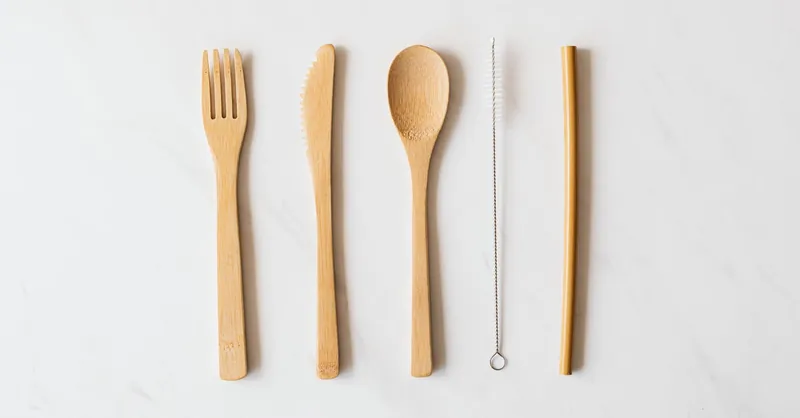
Image courtesy of Photo By: Kaboompics.com
